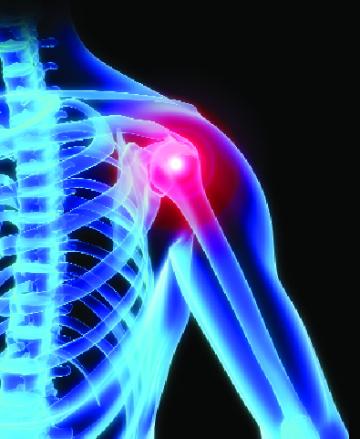Health of Shoulder
Mark Lorenze, MD
 The rotator cuff is the principal group of muscles around the shoulder that help control rotation of the arm and overhead activity. The rotator cuff is comprised of four muscles (supraspinatus, infraspinatus, teres minor and subscapularis) acting in concert to control motion of the shoulder girdle. Rotator cuff tendonitis (impingement syndrome) is a common shoulder problem seen frequently in overhead athletes (paddle players) and throwers.
The rotator cuff is the principal group of muscles around the shoulder that help control rotation of the arm and overhead activity. The rotator cuff is comprised of four muscles (supraspinatus, infraspinatus, teres minor and subscapularis) acting in concert to control motion of the shoulder girdle. Rotator cuff tendonitis (impingement syndrome) is a common shoulder problem seen frequently in overhead athletes (paddle players) and throwers.
The rotator cuff is susceptible to both acute traumatic injuries and damage from overuse. In tennis, rotator cuff disease manifests itself as pain during the act of overhead serving or while striking an overhead. With an acute, sudden injury the player may feel a popping sensation in the shoulder and a sudden onset of sharp pain. With an overuse injury, a player may have more gradual onset of discomfort and weakness. Players with rotator cuff disease also complain of pain with overhead lifting and pain that often awakens them from sleep.
The rotator cuff muscles are susceptible to injury as they pass through a boney channel in the shoulder (subacromial space). As these muscles pass through the tunnel on there way to the tip of the shoulder, they can become inflamed, swollen or even torn. Once inflammation of the rotator cuff occurs, players begin to experience pain that is progressive. Rotator cuff tendonitis is often associated with a small bone spur in the shoulder that can act to further inflame the rotator cuff musculature(so- called impingement syndrome).
The treatment of rotator cuff tendonitis begins with a trial of activity modification, non- steroidal anti-inflammatory medication and physical therapy. If this treatment is ineffective, a cortisone injection is often administered to reduce the inflammation around the rotator cuff; this treatment tends to be very effective for pain relief. On rare cases when the cortisone injection is ineffective or relieves the pain only for a short period of time, the physician will often order an MRI scan to determine the extent of damage to the rotator cuff and to help guide further treatment. If the MRI scan confirms the presence of a large bone spur or extensive damage to the cuff, an arthroscopic procedure may be recommended. Recovery fro this procedure may take 8 months to a year.
Occasionally, a more violent injury to the shoulder (i.e. a sudden fall onto the shoulder) may cause a tear of the rotator cuff musculature. With this injury, the rotator cuff muscles tear away from bone causing significant pain and weakness. If the physician is concerned about this injury, an MRI scan may be ordered immediately and surgery to reattach the muscle to bone is usually necessary. After this procedure is performed, the rehabilitation process is extensive. However, as a general rule, patients do well and can eventually return to their overhead activities.
If a paddle player begins to experience pain with overhead activity, the player should stop the activity that is causing the discomfort and seek orthopaedic care. As with most athletic injuries, it is far easier to treat rotator cuff injuries early in the disease process. Overall, the treatment of rotator cuff pathology is very successful and, after appropriate treatment, most players are able to resume their normal athletic activity and performance.
Any questions regarding shoulder problems? You may email me at: mlorenze@aol.com







